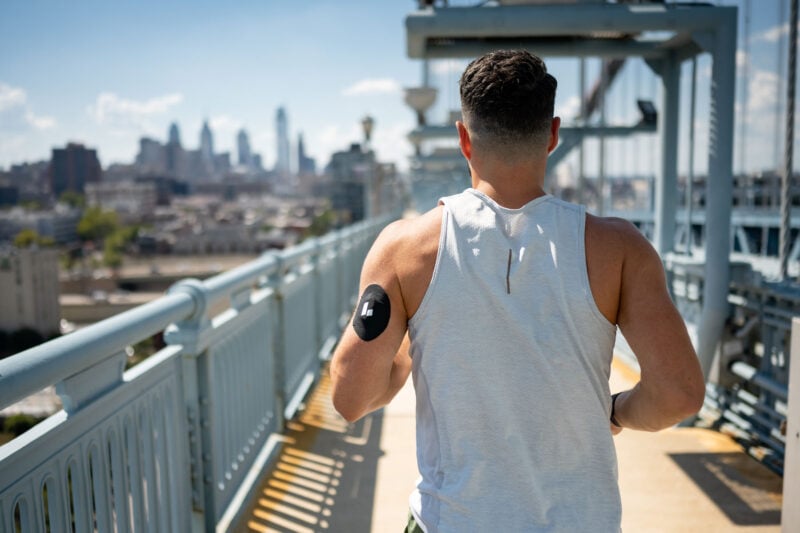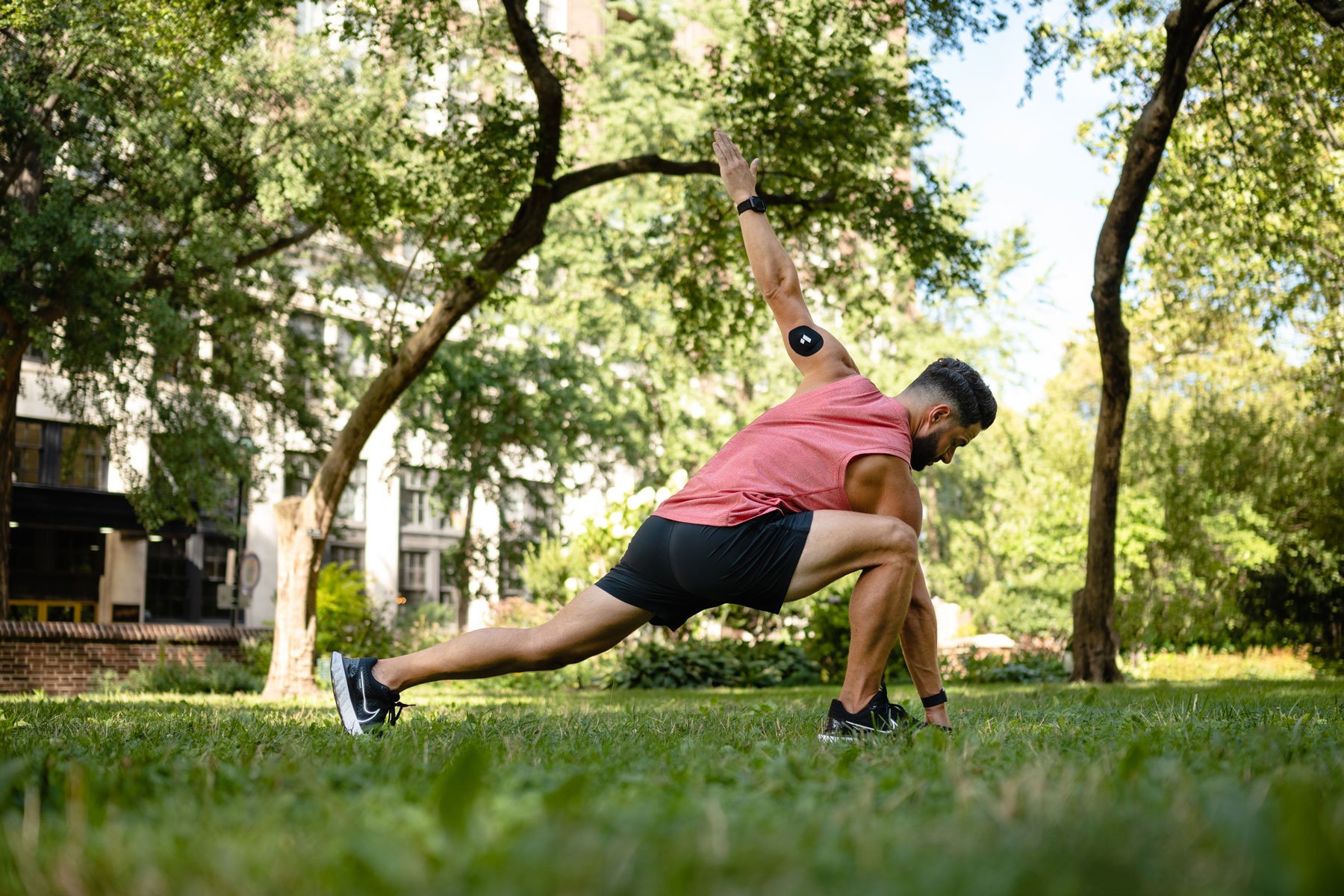Knowing about your individual metabolic responses to foods can make you a better athlete. Instead of following average recommendations, a continuous glucose monitor (CGM) can help inform what—and how much—you need to eat before, during, and after training sessions and competitions to minimize blood sugar spikes and valleys.
That matters for your training, recovery, and competition results. When your blood glucose levels remain relatively stable, your “glycemic variability” is lower. The more you can decrease glycemic variability, the better you’ll compete and the better you’ll replenish the fuel in your muscles (glycogen) after exercise. Small studies of athletes have found that those with more stable glucose during competition perform the best.
Here are some simple, practical ways that athletes can use a CGM to improve performance on race day and maximize recovery the day after intense training.
Learn more:
Optimize Nutrition During Extended Exercise
At lower intensities, your muscles mainly rely on fat as a fuel source. This is “aerobic” exercise. As exercise moves from aerobic to higher intensities—called “anaerobic”—glucose from carbohydrates is used more as the fuel that keeps your muscles firing. This can come from the glucose in your blood but also from stored glucose—called glycogen—in your liver and muscles.
Eventually, these reserves start to run out—fatigue in endurance exercise is associated with a depletion of muscle glycogen and reduced concentrations of blood glucose. Athletes ingest carbohydrates (like an energy gel or sports drink) during longer workouts or races to refuel and keep moving. For athletes who are used to eating low-carb diets and are “fat-adapted”—meaning their bodies preferentially use fat as a fuel source at slightly higher intensities—the loss of glycogen is still happening, but at a lesser rate. And these low-carb athletes may not realize when they’re experiencing a hypoglycemic event: Their bodies produce ketones, filling an energetic gap and keeping the brain fueled. But their muscles are still using glycogen, and in hours-long races and events, even ketogenic athletes need to refuel with carbs.
How much carbohydrate? Anywhere from 30 to 120 grams per hour can maximize performance, according to research. This is a vast range. Eating too little could leave you running out of energy and becoming hypoglycemic, while overeating can cause gastrointestinal distress during the race or training session. Overfeeding can also cause cramping as blood is diverted to your digestive system instead of your muscles.
How to use your CGM: Experiment with different amounts of mid-session carbs in longer training sessions to determine how much you need to maintain performance and relatively stable blood glucose levels throughout longer bouts of exercise. When you look back at the CGM data after the activity, you don’t want to see significant peaks and valleys in your glucose levels throughout the activity—the more you can decrease the glycemic variability, the better off you will be for performance and glycogen replenishment. Ideally, you wouldn’t want relative increases of more than 30 mg/dL on the CGM. What’s essential with the CGM is that it gives you relative changes to your unique physiology. Once you have the data on how many carbs optimize glycogen replenishment for your body, you’ll be equipped with a personalized strategy for your next big training session or competition.
Replenish Carbohydrates After Training
When the glycogen in your muscles and liver is used during exercise, what you eat after training replenishes those stores. For a carb-fueled athlete who doesn’t usually eat a low-carb diet, that means eating a moderate amount of carbohydrates to restore the glycogen that has been used up and pairing those carbs with protein or fat to minimize the post-meal spike in blood glucose. When your blood glucose stays elevated for too long, there’s too much glucose in your bloodstream for your muscles to suck up and use for glycogen replenishment. That overspill of glucose will result in your body storing energy as ectopic fat, a type of fat that surrounds organs and blood vessels but is also found in muscle. This type of fat is associated with metabolic disorders, insulin resistance, and more significant risks for cardiovascular disease.
You may be able to tell that you’ve had too many carbs by how you’re feeling—you may feel bloated and have an upset stomach. But your CGM can also help. Here’s what to look for:
• If your relative glucose increase after a meal is more than 30 mg/dL, it’s likely to be counterproductive. At this point, you may experience counter-regulatory hormone responses that are working against your glycogen replenishment. Counter-regulatory hormones, including cortisol, growth hormone, and epinephrine, increase glucose production from the liver but reduce glucose utilization in the body.
• If your glucose is still elevated 2.5 to 3 hours after your meal, you’ve probably consumed too much carbohydrate. If you’re still seeing elevated glucose levels after this period or longer, you’re experiencing some level of insulin resistance and need to dial back the carbohydrates.
How to use your CGM: Look at the relative increase in your blood glucose levels and how long they stay elevated. If:
- Your post-training meal increase is higher than 30 mg/dL OR
- Your glucose levels remain elevated for more than three hours
You can either:
- Reduce the number of carbohydrates you ingest during the post-workout meal OR
- Eat the same amount of carbs but add protein, fiber, and fat to your meal to dampen the glucose response and
- Go for a walk after the meal to lower your glucose response
Experiment with these changes. You may be able to eat a very high-carb meal—with as many as 300 grams of carbs—and still have a relative increase in glucose levels that’s less than 30 mg/dL. In this case, you’re likely absorbing most of the carbs as glycogen to refill your muscle stores.
Be Smart About Carb Loading
Carbohydrate loading is a systematic approach to nutrition that allows endurance athletes to have more glycogen than they normally would, supersaturating their muscles with glucose that they can use during a long race to sustain energy. This can give racers more of a finishing kick, resulting in faster times during the late stages of a long race.
To get this effect, athletes who carb load start by reducing their carbohydrate intake for a few days, depleting their glycogen stores. Then they increase their carbohydrate intake by 25 to 50 percent and reduce their exercise during a period that’s three to five days before competition. This results in an overcompensation of glycogen—the athletes can have 10 percent or more glycogen onboard when race day comes than they would typically have.
But during the increased carbohydrate phase of carb loading, it’s possible to go overboard—the glycogen stores are filled, and there’s an overspill of carbohydrates, leading to increased glucose levels in the blood.
How to use the CGM: As with replenishing after training, if your glucose is still elevated 2.5 to 3 hours after your meal, you’ve probably consumed too much carbohydrate. Experiment with eating less during your next carb-load phase, or consume less carbohydrate that day during this carb-loading period.
Recreate Your Best Performances
Your best training and competition performances depend on myriad factors, including how you slept the night before, the conditions on a race day, the order of exercises in your training session, your stress levels at work, and even your levels of blood glucose. As seen in studies like this one from 2020, runners with more stable glucose levels during competition performed better.
Just like recreating the same pre-race routine or training plan, the record of CGM levels is another ingredient athletes can use to try to recreate the “recipe” that led to their best or best-feeling performances. Your CGM readings from the days leading to the performance—and the day of the record-breaking performance—can inform what you’re trying to do again to repeat or exceed your personal bests.
For example, your average blood glucose can be a good indication of your readiness for heavy exercise. If your glucose is persistently elevated on your rest day, your body could be in a state of inflammation and need more rest.
Or if your blood glucose is consistently low on a rest day and you’re getting a lot of hypoglycemic events during the day, your body’s probably a little low on energy reserves. This can particularly be true for athletes required to make weight or lose significant weight for a competition, like a wrestler, fighter, or bodybuilder.
But on a day where you’re well-rested, and your energy reserves are low and stable throughout the rest day, your insulin sensitivity is high, and your body is primed for a good workout the next day.
How to use your CGM: If there was a workout that felt great or a race where you performed well, use the historical CGM data—along with food, sleep, and training logs—to try to recreate the conditions that led to previous bests.
For example, if I have a big workout tomorrow where I want to lift really heavy, I will eat more the day before, eating my regular diet but with maybe 20 percent more calories. And then I kind of undereat the day of the workout going in, where I want my mind to be clear, and I don’t want my digestive system working too hard, pulling energy reserves away from my muscles. That way, I feel like my mental and physical reserves can be focused on that particular workout, and I get better results.
Interested in using a CGM?
Levels, the health tech company behind this blog, helps people get CGMs shipped directly to their door, and to understand their data to track meals and performance over time. Click here to learn more about Levels.









